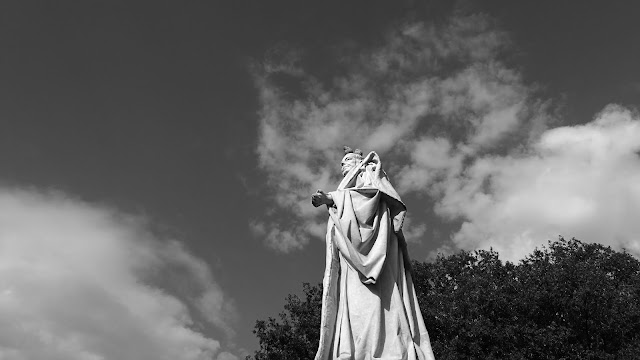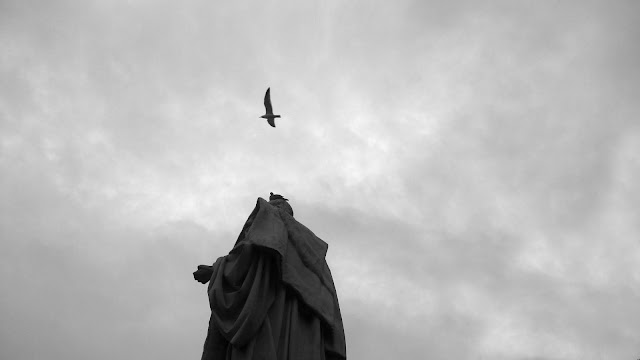If the contemporaneousness has renounced for a long time to the celebratory work it is true that it feels the duty to take care of the images of the past, boasting, in any case, its own history.
From 1894 Giuseppe Manno inhabits the public gardens of the city but he cannot be said to have been a happy tenant. Without a commemorative plaque that respects, in a precarious state the letters of the name that do not say the identity, deprived of a finger never rebuilt, Giuseppe Manno ended up slummy in the conscience of his countrymen who have never manifested particular About his presence and his high historical and political talents. That the time of redemption has come? The 150 years after his death are a good opportunity to repair the wrongs suffered and reconcile the magistrate with his hometown. The task of restoring life and emotions to his image was taken by Roberta Filippelli who, on that solemn and melancholy figure, had already repeatedly stopped her photographic objective, convinced that the only public statue needed to devote Attention to investigate its origins, state of health, shape and visibility in urban aesthetics. The work required time, patience and even fascination exercised by an inscrutable portrait left by the rectory and reinterpreted with uninhibited taste to make it descend from the pedestal and reinstate it in the collective imagination. In fact, Manno, in the work of Roberta Filippelli, appears to us usually alone, isolated and far from the noise that revolves around him, thoughtful and apprehensive as he was in real life. Viewed from different angles, spied under changing skies, transformed by the quality of light, the photographic portrait acquires a dimension close and distant at a time: Figure camouflaged by the daily visual Automatism, is investigated in its Physical and somatic qualities from lowered, escorted, behind shots, which return the physiognomy in its unstable perception and make the Baron more human than idealized. Yet motionless in the emptiness of a space crossed by the flight of the birds, by the passage of the clouds, by the sudden itineraries of light, the image of the illustrious man floats in the dimension of the myth, returned to history by the statuary monumentality and From photography that enhances its political and cultural authoritativeness. But with a skillful play of mingling, Manno rises, in the works of Roberta Filippelli, above the horizontality of the sea that will separate him forever from the island. The fascination of these images, which in the visual narrative become passages of existence, can be perceived in the multimedia of the proposals that dwell on the surface of the water, on the violent sea ripples, on the labile and vast boundaries of horizons dear to man Far from his Earth constantly present in his own memories. He reconstructs, thus, in the black and white compositions, the possible journeys around his native house, the spaces of childhood and memory, the suggestions of a place lost forever.
And then to overcome the sadness and rhetoric of anniversaries Roberta Filippelli interprets the "Ecce. Mo magistrate" in a ludically pop vision. T-shirt, gadgets, symbolic objects, animate a surprising exhibition, scattered in the halls of the House-Museum as a surprise game that solicits the search, exacerbates the curiosity, restores the physiognomy in the round of an attentive and hospitable landlord.
solo exhibition of Roberta Filippelli curated by Mariolina Cosseddu
Museum House Manno via Santa Barbara, 23 - Alghero
Se la contemporaneità ha rinunciato da tempo all’opera celebrativa è però vero che sente il dovere di prendersi cura delle immagini del passato, vanto, in ogni caso, della propria storia.
Dal 1894 Giuseppe Manno abita i giardini pubblici della città ma non può dirsi sia stato un inquilino felice. Senza una targa commemorativa che si rispetti, in stato precario le lettere del nome che non dicono l’ identità, privato di un dito mai ricostruito, Giuseppe Manno ha finito per assopirsi nella coscienza dei suoi concittadini che non hanno mai manifestato particolare riguardo alla sua presenza e alle sue alte doti storiche e politiche. Che sia giunta l’ora del riscatto? I 150 anni dalla sua morte sono una buona occasione per riparare ai torti subiti e riconciliare il magistrato con la sua città natale. Il compito di restituire vita ed emozioni alla sua immagine se l’è assunto Roberta Filippelli che, su quella figura solenne e malinconica, aveva già fermato più volte il suo obiettivo fotografico, convinta che a quell’unica statua pubblica occorresse dedicare attenzione per indagarne origini, stato di salute, forma e visibilità nell’estetica urbana. Il lavoro ha richiesto tempo, pazienza e persino fascinazione esercitata da un imperscrutabile ritratto lasciato dal Canonica e reinterpretato con gusto disinibito per farlo scendere dal piedistallo e reintegrarlo nell’immaginario collettivo. In realtà Manno, nel lavoro di Roberta Filippelli, ci appare solitamente solo, isolato e lontano dal chiasso che gli ruota attorno, pensieroso e apprensivo come lo era nella vita reale. Osservato da angolazioni diverse, spiato sotto cieli mutevoli, trasformato dalla qualità della luce, il ritratto fotografico acquista una dimensione vicina e lontana ad un tempo: figura mimetizzata dall’automatismo visivo quotidiano, viene indagata nelle sue qualità fisiche e somatiche dagli scatti ribassati, scorciati, retrostanti, che ne restituiscono la fisionomia nella sua instabile percezione e rendono il barone personaggio più umano che idealizzato. Eppure immobile nel vuoto di uno spazio attraversato dal volo degli uccelli, dal passaggio delle nuvole, dagli improvvisi itinerari di luce, l’immagine dell’uomo illustre galleggia nella dimensione del mito, riconsegnata alla Storia dalla monumentalità statuaria e dalla fotografia che ne esalta l’autorevolezza politica e culturale. Ma con un abile gioco di commistioni, Manno si eleva, nei lavori di Roberta Filippelli, al di sopra dell’orizzontalità del mare che lo separerà per sempre dall’isola. Il fascino di queste immagini, che nel racconto visivo diventano brani di esistenza, si coglie nella multimedialità delle proposte che si soffermano sulla superficie dell’acqua, sulle violente increspature marine, sui confini labili e vasti di orizzonti cari all’uomo lontano dalla sua terra costantemente presente nei propri ricordi. Ricostruisce, così, nelle composizioni in bianco e nero, i possibili tragitti attorno alla sua casa natale, gli spazi dell’infanzia e della memoria, le suggestioni di un luogo perduto per sempre.
E allora per superare la tristezza e la retorica degli anniversari Roberta Filippelli interpreta l’ “ecce.mo Magistrato” in una visione ludicamente pop. Maglietta, gadget, oggetti simbolici, animano una mostra sorprendente, disseminata nelle sale della casa-museo come un gioco a sorpresa che sollecita la ricerca, acuisce la curiosità, restituisce la fisionomia a tutto tondo di un padrone di casa attento e ospitale.
personale di Roberta Filippelli a cura di Mariolina Cosseddu
Museo Casa Manno via Santa Barbara, 23 - Alghero
stickers
my place is here - il mio posto è qua
© Roberta Filippelli 2018







































Nessun commento:
Posta un commento